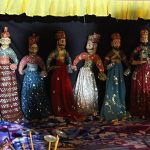
The story behind Kathputli is that a long time ago, a king ordered all the toys in his kingdom to be burned, including the beloved puppets of a group of wandering performers.
India’s 4,000-Year-Old Metal Casting Marvel


Dhokra art, a mesmerizing dance between fire and metal, boasts a legacy that stretches back over 4,000 years. This ancient Indian art form, practiced by the indigenous communities of Chhattisgarh and Odisha, breathes life into exquisite metal sculptures using the lost-wax casting technique. Each Dhokra piece, imbued with the essence of tradition, narrates a captivating story of cultural heritage and artistic brilliance
Dhokra Art: A Glimpse into the Mesmerizing Technique
The meticulous process of Dhokra art is as captivating as the finished product itself. Here’s a glimpse into the magic behind this timeless art form:
Dhokra Art: More Than Just Exquisite Sculptures
Dhokra art transcends the realm of mere aesthetics. It serves as a repository of India’s cultural heritage, passed down through generations. Each Dhokra piece embodies the beliefs, traditions, and artistic sensibilities of the indigenous communities that practice this art form.
The Encroaching Threat: The Need for Revival
In the face of mass-produced goods and a decline in younger artisans taking up the mantle, Dhokra art, like many other traditional art forms, faces the threat of extinction.
What Can We Do?
Supporting Dhokra art is not just about acquiring a beautiful sculpture; it’s about preserving a vital thread in the rich tapestry of Indian culture. Here’s how you can contribute:
By taking these steps, we can ensure that the legacy of Dhokra art continues to captivate future generations, serving as a testament to the enduring spirit of Indian craftsmanship.
Looking to Explore Dhokra Art Further?
Let’s join hands to celebrate the timeless beauty of Dhokra art and ensure its legacy continues to inspire for years to come.
Image credit:

The story behind Kathputli is that a long time ago, a king ordered all the toys in his kingdom to be burned, including the beloved puppets of a group of wandering performers.

The first thing to understand about ONDC is that it is not another application or platform but just a set of specifications. Let us take this with an example of doing a journey of a complete transaction.

Shivrai coins are a series of historic coins that were issued during the rule of Chhatrapati Shivaji Maharaj, the founder of the Maratha Empire in India. These coins have played an important role in the history of Maharashtra and India.